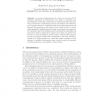SIAMDM
2010
14 years 7 months ago
2010
Sorting permutations by transpositions is an important and difficult problem in genome rearrangements. The transposition diameter TD(n) is the maximum transposition distance among ...
111
click to vote
JCB
2008
15 years 12 days ago
2008
A centromere is a special region in the chromosome that plays a vital role during cell division. Every new chromosome created by a genome rearrangement event must have a centromer...
135
click to vote
JDA
2007
15 years 24 days ago
2007
In the median problem, we are given a distance or dissimilarity measure d, three genomes G1, G2, and G3, and we want to find a genome G (a median) such that the sum 3 i=1 d(G, Gi...
110
click to vote
BMCBI
2010
15 years 1 months ago
2010
Background: The rapidly increasing availability of whole-genome sequences has enabled the study of whole-genome evolution. Evolutionary mechanisms based on genome rearrangements h...
112
click to vote
BIBE
2007
IEEE
15 years 7 months ago
2007
IEEE
Abstract—Because of the advent of high-throughput sequencing and the consequent reduction in cost of sequencing, many organisms have been completely sequenced and most of their g...
116
click to vote
RECOMB
2009
Springer
15 years 7 months ago
2009
Springer
In genome rearrangements, the double cut and join (DCJ) operation, introduced by Yancopoulos et al., allows to represent most rearrangement events that could happen in multichromos...
127
click to vote
RECOMB
2006
Springer
16 years 1 months ago
2006
Springer
Abstract. During evolution, genomes are subject to genome rearrangements that alter the ordering and orientation of genes on the chromosomes. If a genome consists of a single chrom...



